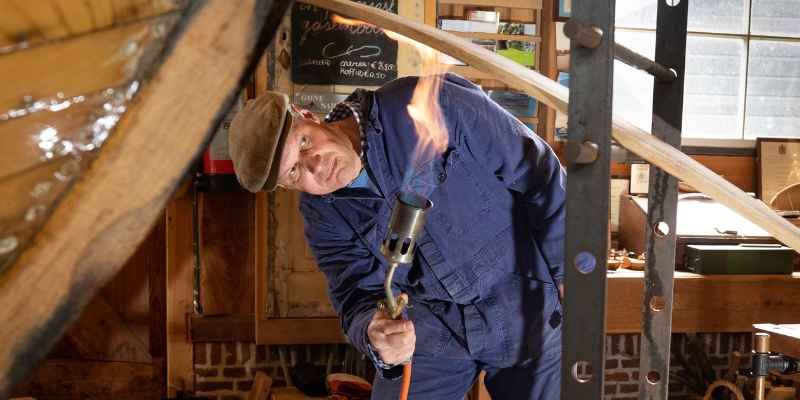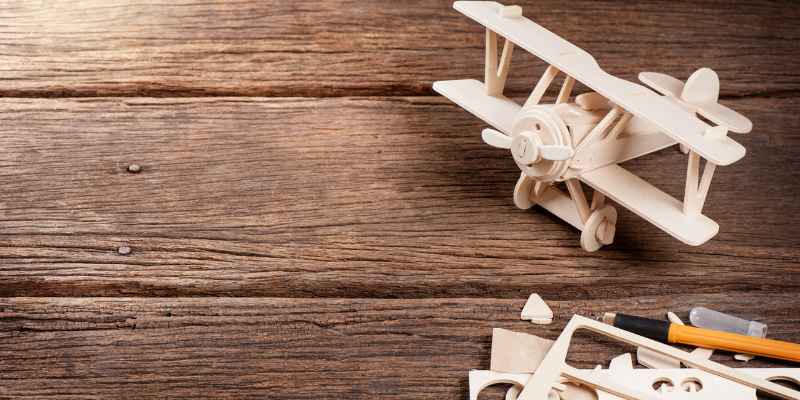To bend balsa wood, dampen one side to make it curve away from the dampened side or apply heat to make it curve towards the heated side. Soaking the wood in a liquid can also make it easier to bend.
Another method is to use a mold to help maintain the curve. There are alternatives to bending balsa wood, such as soaking and steaming it or using thinner balsa and laminating it together. Diluted ammonia or vinegar can be used to soften the wood for bending.
Properties Of Balsa Wood
To bend balsa wood, dampen one side of the wood, and it will naturally curve away from the dampened side. Alternatively, you can apply heat using a hot iron to make it curve towards the heated side. Another method is to soak the wood in Windex or a mixture of ammonia and water, then clamp the parts to a frame structure and let it dry in the desired shape.
Balsa wood is a popular material for various crafts and hobbies due to its unique properties. Let’s explore the key characteristics of this lightweight and durable wood.
Lightweight And Durable
One of the standout features of balsa wood is its lightweight nature. It is considered one of the lightest woods available, making it easy to work with and manipulate. Despite its low density, balsa wood maintains its strength and durability, ensuring that your projects can withstand regular use.
Open Cell Structure
The open cell structure of balsa wood is another significant property that sets it apart from other types of wood. Its cells are interconnected, creating a porous material that is highly receptive to moisture and heat. This unique structure allows balsa wood to bend and flex without breaking, making it ideal for applications such as model aircraft, boats, and architectural models.
When it comes to bending balsa wood, there are various methods you can employ. Dampening one side of the wood will cause it to curve away from the dampened area, while applying heat through a hot iron will make it curve towards the heated side. You can also use Windex or steam to soften the wood and make it more pliable for bending.
Overall, balsa wood’s lightweight and durable nature, coupled with its open cell structure, make it an excellent choice for bending and shaping. Whether you’re a model enthusiast or a hobbyist, understanding the properties of balsa wood will allow you to unleash your creativity and create stunning projects.
Methods Of Bending Balsa Wood
Bending balsa wood can be a crucial technique in various crafting and model-making projects. There are several methods that you can use to bend balsa wood effectively. Let’s explore three common techniques:
Dampening Technique
The dampening technique involves moistening the balsa wood fibers to make them more pliable for bending. Simply dampen the wood with water on one side, and it will naturally start to curve in that direction.
Steam Bending
Steam bending is another effective method for bending balsa wood. By subjecting the wood to steam or very hot water, you can soften the fibers, making them easier to bend into the desired shape.
Application Of Heat
Applying heat to balsa wood can also facilitate bending. By using a hot iron or other heat source, you can soften the wood fibers and mold them into the desired curvature.
Tools And Materials
Bending balsa wood requires the right tools and materials for a successful outcome.
Essential Tools For Bending
- Steam Generator: Use steam to soften the balsa wood for easier bending.
- Clamps: Secure the wood in the desired shape until it cools and sets.
- Heat Source: A hot iron or heat gun can help bend the wood in specific areas.
- Safety Gear: Gloves and eye protection are essential when working with hot tools.
Selecting The Right Balsa Wood
Choosing the correct type of balsa wood is crucial for successful bending.
- Thickness: Thinner sheets are easier to bend than thicker pieces.
- Grade: Select high-quality balsa wood for optimal flexibility.
- Moisture Content: Dampening the wood slightly can aid in the bending process.
- Flexible Grain: Look for balsa wood with a straight and even grain for better results.
Step-by-step Guide

Here is a detailed Step-by-Step Guide on how to bend balsa wood effectively.
Preparing The Balsa Wood
Before bending balsa wood, make sure to prepare it properly:
- Choose the right thickness: Opt for thin balsa wood for easier bending.
- Moisten the wood: Spray or dampen the wood to make it more pliable.
- Use a mold: Place the balsa wood onto a mold to help maintain the desired shape.
Bending Techniques
When bending balsa wood, follow these techniques:
- Steam bending: Soften the wood with steam before bending to achieve a smooth curve.
- Heat bending: Apply heat to the wood using an iron to create curved shapes.
- Multiple cuts: Create kerf cuts on the wood to increase flexibility before bending.
Common Mistakes To Avoid
Ensure you avoid these common mistakes when bending balsa wood:
- Over-soaking: Do not leave the wood in liquid for too long as it can weaken the structure.
- Using excessive heat: Be cautious with heat as it can cause the wood to crack or burn.
- Skipping preparation: Always prepare the wood before bending to prevent breakage.
Expert Tips And Tricks
To flex balsa wood, first dampen one side to initiate curvature, or apply a hot iron to curve it in the opposite direction. Length of moisture exposure determines ease of bending. Incorporating a mold during softening ensures the wood maintains the desired shape.
Advanced Bending Methods
Bending balsa wood requires advanced methods to achieve the desired shapes and forms. One such technique is to use steam to soften the wood fibers, making it more pliable for bending. Another method involves creating multiple cuts, known as kerf-cuts, on the back of the wood to facilitate the bending process.
Perfecting The Bend
Perfecting the bend of balsa wood involves several key steps. First, it’s essential to soften the wood using steam or hot water to make it more flexible. Next, shaping the wood to the desired form while it’s still pliable is crucial. Finally, allowing the wood to cool and set in the desired shape will help to perfect the bend.
Innovative Applications
Balsa wood is a versatile material known for its lightweight and easy-to-work-with nature. Its innovative applications extend beyond traditional uses, finding unique and creative roles in various industries. Let’s explore some of the innovative applications of bending balsa wood.
Artistic And Creative Uses
Balsa wood’s flexibility makes it an ideal medium for artistic expression. Artists and sculptors harness its bendable nature to create intricate and awe-inspiring sculptures, adding depth and organic flow to their masterpieces. The ability to mold balsa wood to fit artistic visions allows for the unleashing of creativity in diverse forms such as abstract art, architectural models, and decorative elements.
Bending For Model Making And Crafts
In the world of model making and crafts, balsa wood bending serves as a crucial technique. It finds extensive application in model aircraft construction, architectural models, and miniature furniture crafting. The pliability of balsa wood allows craftsmen and hobbyists to impressively replicate shapes and curves, enriching their creations with intricate details and realism.
Troubleshooting And Faqs

To bend balsa wood, dampen one side of the wood to make it curve away and use a hot iron to make it bend towards the heated side. Soaking wood in Windex or steam can also soften it for bending.
Another method is kerf-cutting to make it pliable before forming it into the desired shape.
Issues With Bending
If you’re experiencing issues with bending balsa wood, here are a few common problems and their solutions:
| Issue | Solution |
|---|---|
| The balsa wood is not bending easily | Try soaking the wood in water for a longer period of time to increase its pliability. |
| The balsa wood is cracking or breaking during bending | Make sure the wood is dampened evenly and avoid applying too much pressure while bending. Additionally, you can score the back of the wood using a saw to make it more flexible. |
| The balsa wood is not maintaining its shape after bending | Once you have achieved the desired bend, use clamps or rubber bands to hold the wood in place until it dries completely. This will help the wood maintain its shape. |
Frequently Asked Questions
-
- Is balsa wood good for bending?
Balsa wood is excellent for bending due to its lightweight and flexible nature. The longer you soak it in water, the easier it becomes to bend.
-
- How do you bend balsa wood with Windex?
You can use standard Windex with ammonia to bend balsa wood. Simply spray Windex onto the wood, clamp it to a frame structure, and let it dry. The ammonia in Windex helps soften the wood and make it more malleable.
-
- What is the easiest way to bend wood?
The easiest way to bend wood is by softening it using steam or hot water and then forming it into the desired shape. Another method is kerf-cutting, which involves making multiple cuts on the back of the wood to increase its flexibility.
-
- What is the best method to bend balsa?
One effective method is to quickly bend a piece of balsa wood to the required radius using your hands. Blow on the part to cool it down and help it retain the shape.
-
- Can diluted ammonia be used to bend balsa wood?
Yes, diluted ammonia can be used to bend balsa wood. However, it’s important to use the correct ratio of ammonia to water to avoid damaging the wood. Consult a guide or expert for the recommended mixture.
Frequently Asked Questions On How To Bend Balsa Wood
How Do You Bend Balsa Wood At Home?
To bend balsa wood at home, dampen one side to make it curve away or use a hot iron to curve towards the heated side. You can also soften it with steam or boiling water before shaping it. Another method is to make multiple cuts on the back of the wood to increase flexibility.
Is Balsa Wood Good For Bending?
Yes, balsa wood is good for bending. You can dampen one side to curve it or apply heat to bend it.
How Do You Bend Balsa Wood With Windex?
To bend balsa wood with Windex, soak the wood with a Windex and water mix, then clamp and let it dry.
What Is The Easiest Way To Bend Wood?
The easiest way to bend wood is by softening it first with steam or hot water. Alternatively, you can create multiple cuts on the back of the wood using a saw, a technique known as kerf-cutting. Once the wood is softened, you can shape it to your desired curve.
Conclusion
In order to effectively bend balsa wood, there are a few key techniques to keep in mind. Dampening one side of the wood will cause it to curve away from the dampened side, while applying heat will cause it to curve towards the heated side.
Additionally, using a mold can help retain the desired shape. It’s also important to note that the longer the wood is soaked in liquid, the easier it will be to bend. So, whether you’re working on a woodworking project or building model planes, these tips will help you achieve the desired results.


